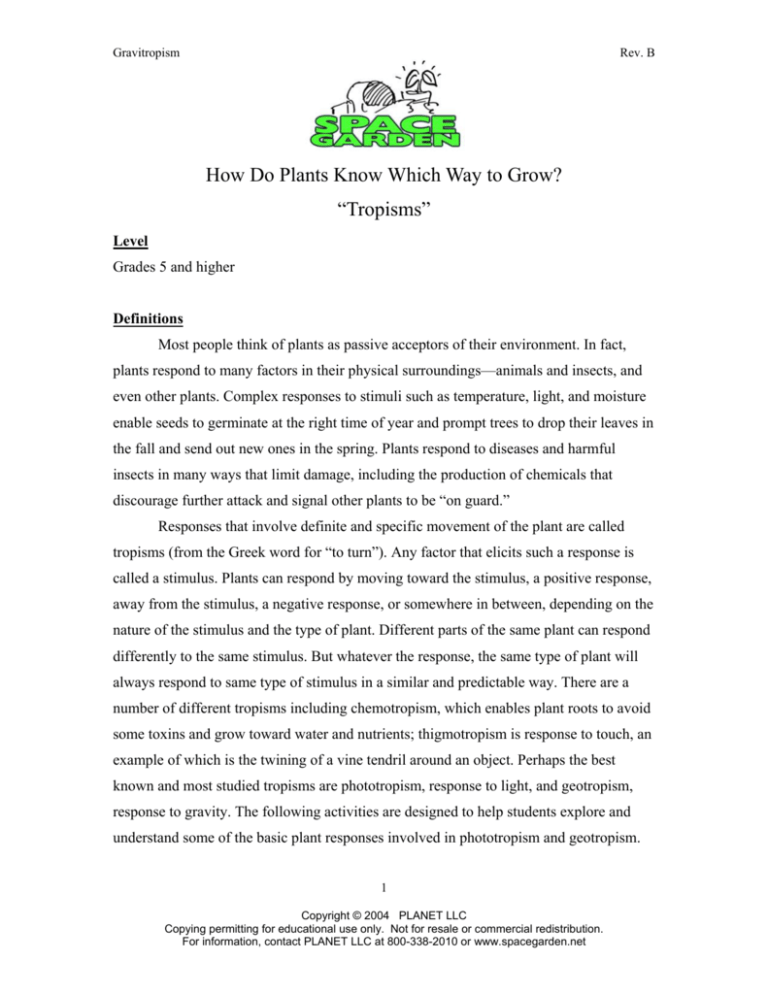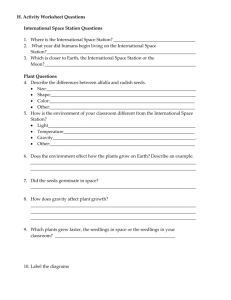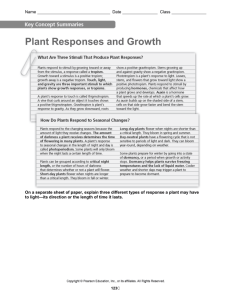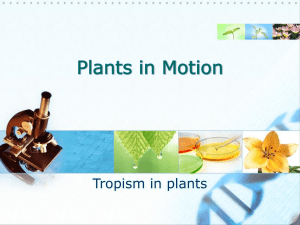How Do Plants Know Which Way to Grow
advertisement

Gravitropism Rev. B How Do Plants Know Which Way to Grow? “Tropisms” Level Grades 5 and higher Definitions Most people think of plants as passive acceptors of their environment. In fact, plants respond to many factors in their physical surroundings—animals and insects, and even other plants. Complex responses to stimuli such as temperature, light, and moisture enable seeds to germinate at the right time of year and prompt trees to drop their leaves in the fall and send out new ones in the spring. Plants respond to diseases and harmful insects in many ways that limit damage, including the production of chemicals that discourage further attack and signal other plants to be “on guard.” Responses that involve definite and specific movement of the plant are called tropisms (from the Greek word for “to turn”). Any factor that elicits such a response is called a stimulus. Plants can respond by moving toward the stimulus, a positive response, away from the stimulus, a negative response, or somewhere in between, depending on the nature of the stimulus and the type of plant. Different parts of the same plant can respond differently to the same stimulus. But whatever the response, the same type of plant will always respond to same type of stimulus in a similar and predictable way. There are a number of different tropisms including chemotropism, which enables plant roots to avoid some toxins and grow toward water and nutrients; thigmotropism is response to touch, an example of which is the twining of a vine tendril around an object. Perhaps the best known and most studied tropisms are phototropism, response to light, and geotropism, response to gravity. The following activities are designed to help students explore and understand some of the basic plant responses involved in phototropism and geotropism. 1 Copyright © 2004 PLANET LLC Copying permitting for educational use only. Not for resale or commercial redistribution. For information, contact PLANET LLC at 800-338-2010 or www.spacegarden.net Gravitropism Rev. B Gravitropism Activity Introduction Many different explanations have been proposed for why plant shoots grow “up” and roots grow “down.”1 Scientists have conducted experiments to clarify this phenomenon since at least the early nineteenth century when A. de Candolle showed that moisture was not the determining factor. British physiologist A. Knight demonstrated that root tips are not pulled downward by their own weight.2 Others have observed that shoots of plants kept in the dark still grow up and roots still grow down, so light was also ruled out as the sole reason plants grow the way they do. In 1806 A. Knight conducted an experiment that clearly demonstrated the influence of gravity on plant growth. Dr. Knight fixed seedlings to a rotating wheel, thereby subjecting them to the artificial, gravity-like pull of centrifugal force. The plants’ roots grew downward at approximately a 45° angle, the result of both centrifugal force and gravity.3 Today we know that plants growing on earth have evolved to respond to many different stimuli to help them orient themselves to their best advantage. As you can discover in the phototropism activity, light is an important factor in determining the direction of plant growth. But gravity, the force that causes bodies to fall to the earth and holds the planets in their orbits about the sun, is also critically important. The effect of light on plant growth is called phototropism. The effect of gravity on the direction of plant growth is called gravitropism.4 Together, both forces, light and gravity, are primarily responsible for enabling plants to establish a clearly defined vertical growth 1 The growth of roots downward, in the direction of the pull of gravity, is called positive gravitropism and the growth of shoots upward, away from the pull of gravity, is called negative gravitropism. Other plant parts, such as root hairs and leaves, may exhibit transversal gravitropism, growing perpendicular to the main up-down axis of the plant. 2 3 4 Reference 6 The experiment worked whether the wheel was in a vertical or a horizontal position. Reference 6 The effect of gravity on plant growth is often called geotropism because the earth itself (geo) is responsible for the stimulus. Recently, NASA has begun to use the term gravitropism to describe the effects of the pull of gravity, real or artificial, on the up-down plant growth response. 2 Copyright © 2004 PLANET LLC Copying permitting for educational use only. Not for resale or commercial redistribution. For information, contact PLANET LLC at 800-338-2010 or www.spacegarden.net Gravitropism Rev. B axis that puts shoots and roots in their “proper” places. While light causes shoots to grow toward it (and roots to go the other way); gravity has the opposite effect. As you can demonstrate, light can be used to change the direction of a plant’s growth, thereby overcoming somewhat the effect of gravity. But in the absence of light, shoots and roots use the force of gravity alone to orient themselves in an up-down direction. Early experiments in the reduced gravity of space have shown that “Tissues of flight plants appeared normal and seedlings differed only in the lack of orientation of roots and shoots.”5 In the absence of gravity, scientists growing plants for experiments rely on the phototropic response to orient plant shoot growth. (The foam pad used in the Space Garden to help retain the Arcillite rooting medium also helps to keep the roots from inadvertently growing into the light.) Question Without light, how do plants know which way to grow? Hypothesis Plants use the force of gravity to help them know which way to grow. Design Students will set up and conduct an experiment to demonstrate the effects of gravity on plant growth. They will consider the difficulties of designing an experiment that separates the effects of stimuli (light and gravity) that have similar responses (directional growth). While slow rotation of seedlings can cancel the effect of gravity,6 faster rotation can create centrifugal force to compete with it. But equipment for such experiments requires significant construction and expense. A simpler technique for demonstrating gravity is to change the orientation of seedlings germinated in the dark, as will be done in this activity. Students will also consider the problem of controlling 5 6 Reference 7 Reference 8 3 Copyright © 2004 PLANET LLC Copying permitting for educational use only. Not for resale or commercial redistribution. For information, contact PLANET LLC at 800-338-2010 or www.spacegarden.net Gravitropism Rev. B variables in order to ensure that the effect seen is the result of the variable being tested. Timeframe Time will be required on at least 4 days. y Some time will be needed on the day prior to setting up the experiment to select and begin to soak the seeds and to discuss gravitropism, experimental design and expected outcomes for the experiment. y One 50-minute class period will be needed to set up the experiment. y Less than one 50-minute class period will be needed after 3-5 days to change the placement of the Space Garden and to observe, document, and discuss the seedlings’ growth to this point. y A final 50-minute class period will be required to observe, document, measure, and discuss changes in the seedlings’ orientation since the Space Garden was moved. y Additional time may be needed to collate data and present the results. Learning Objectives Students participating in this activity will: y Learn about the effects of gravity on plant growth y Learn principles of experimental design y Gain experience in measurement y Gain experience in data collection, analysis and presentation Materials Space Garden bases Arcillite De-ionized or distilled water Large seeds with an obvious orientation (bean and/or corn) Strong absorbent paper (like filter paper, or a large coffee filter) Instant-bond “super” glue Waxed paper 4 Copyright © 2004 PLANET LLC Copying permitting for educational use only. Not for resale or commercial redistribution. For information, contact PLANET LLC at 800-338-2010 or www.spacegarden.net Gravitropism Rev. B Light exclusion chambers Black electrical tape Camera or materials for sketching Dish drainer (optional) 5 Copyright © 2004 PLANET LLC Copying permitting for educational use only. Not for resale or commercial redistribution. For information, contact PLANET LLC at 800-338-2010 or www.spacegarden.net Gravitropism Rev. B Procedure 24 hours before setting up the experiment 1. Discuss the principle of gravitropism and how it can be detected in earth’s gravity. Discuss why it is important to exclude light from the germinating seedlings. 2. Students select seeds (seeds should be uniform in size and the seed coat should be undamaged). 3. Place seeds in water to cover them by at least ½ inch. Be sure to soak enough seeds for the control. Also soak a few extra seeds that can be used to help monitor seed growth without opening the experimental chambers. 4. Assemble light exclusion chambers as needed and place them over the seeds in water. End of Day Day 1 Experimental set up 1. For each Space Garden base to be used, measure and cut a rectangle from the absorbent paper to fit the entire surface of the Space Garden base (approximately 6.5 X 5.25 inches). 2. Center the foam base on the paper rectangle and draw around it to mark the area in which the plants will be placed. 3. Decide how seeds will be placed on the rectangle. There are many options for placement, just be sure that the hila, or eyes, point in at least the four major directions (up, down, left and right) and that each orientation is repeated several times, either by the same group or for all the groups collectively. 7 4. Mark the spots for the seed placement within the outlined area on the absorbent paper. 5. Fill the base of the Space Garden almost full with Arcillite. Thoroughly moisten the Arcillite. 7 It is interesting to compare the reactions of different types of seeds. Beans and corn may be used at the same time if the group is large enough so that there can be several replications for each orientation for each seed type. If the group is small, these experiments could be done separately. 6 Copyright © 2004 PLANET LLC Copying permitting for educational use only. Not for resale or commercial redistribution. For information, contact PLANET LLC at 800-338-2010 or www.spacegarden.net Gravitropism Rev. B 6. Remove seeds from the water and dry them thoroughly on paper towels. 7. Spread waxed paper on the work surface under absorbent paper to protect the surface. 8. Using a small amount of non-water-soluble (“super”) glue, attach each seed in its assigned place and location on the absorbent paper. 9. After assuring that the seeds are firmly attached, moisten the paper and place it with the seeds (seeds facing out) onto the Space Garden base, aligning the outline drawn earlier with the rim of the well holding the Arcillite. 10. Secure the paper by engaging the snap-close locks at the corners of the Space Garden base. 11. Sketch or photograph the experimental set up, showing the placement of the seeds. 12. Place a light exclusion chamber over the seeds and secure the edges with black electrical tape. 13. Place the entire unit in a vertical position, with the water port facing up. A dish drainer is a handy way to hold the units in place and to protect the table surface from any water that may leak out. 14. One or two control units should be prepared at the same time. If one control unit is used, place it in the vertical position, just like the experimental units. If a second control unit is used, place it in the vertical position but rotated 90° so that it rests on one of the short sides, with the water port facing to the right. 15. Keep some seeds wrapped in a moist paper towel and covered with a light exclusion chamber. Look at these seeds every few hours after the first 48 hours. When roots and shoots have emerged enough that the direction of growth can be determined, the seeds in the experimental chambers are ready for the next step. Don’t open the experimental chambers until you are going to change the orientation. End of Day 1 Day 2, 48 - 72 hours after Day 1; reorienting the seedlings 1. When the monitor seeds show shoot and root growth, open the experimental and control chambers. 7 Copyright © 2004 PLANET LLC Copying permitting for educational use only. Not for resale or commercial redistribution. For information, contact PLANET LLC at 800-338-2010 or www.spacegarden.net Gravitropism Rev. B 2. Photograph or sketch the seedlings. 3. Working quickly, measure and record the length of shoots and roots. Try not to move or disturb the seedlings’ placement. 4. Note the up-down direction of growth. Did the roots and/or shoots change from their direction of initial emergence to reach that orientation? 5. Replace and reseal the light exclusion chamber. 6. Rotate the experimental units so that they stand vertically, resting on a short side with the water port facing to the right. Do not change the orientation of the control unit(s). End of Day 2 Day 3, 24 hours later; observing the effects of gravitropism 1. Open the experimental chambers. 2. Photograph or sketch the seedlings. 3. Measure the length of the roots and shoots. Have they grown longer? 4. Have the roots and/or shoots changed their direction of growth? (The answer should be yes.) 5. Have the roots and/or shoots changed their up-down orientation? (The answer should be no. The change in direction of growth should have enabled the seedlings to reestablish their alignment with gravitational pull.) 6. Measure the angle of change in direction in root and shoot growth. The change should be approximately 90° for the experimental plants. The control plants should be unchanged. 8 Copyright © 2004 PLANET LLC Copying permitting for educational use only. Not for resale or commercial redistribution. For information, contact PLANET LLC at 800-338-2010 or www.spacegarden.net Gravitropism Rev. B Concluding activities and further questions y Did the plants bend (change direction) in response to gravity? y Did they all bend by the expected amount? What factors might cause the angle to be different (e.g., not enough time for the plants to adjust; an obstacle in the way; plants not actively growing)? y Did some plants not bend? If so, which ones? Why? y Did the control plants change their direction of growth or orientation? y Did the plants grow (increase in length)? Did they all grow by the same amount? y What is the orientation of the leaves? Do you think the orientation of the leaves is affected by gravity? y Were the measurements similar for each unit of the experimental units? y Can we accept the hypothesis? (Seedlings will bend and grow toward in response to gravity.) y Present results with photos/drawings, narrative description and tables or graphs comparing growth and change in test versus control plants. Extension y Demonstrate the interaction between light and gravity. Which is stronger? y Try different plants. Do some types of plants respond more strongly than others? y How quickly do plants respond to gravity? y Reposition the Space Garden in a different way each day and look at the plant form after repeating this several times. y If possible, set up a device to rotate the chambers - slowly to cancel the effect of gravity or more quickly to counteract it. 9 Copyright © 2004 PLANET LLC Copying permitting for educational use only. Not for resale or commercial redistribution. For information, contact PLANET LLC at 800-338-2010 or www.spacegarden.net







